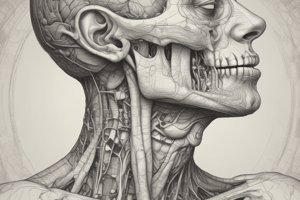Podcast
Questions and Answers
Where does the esophagus begin?
Where does the esophagus begin?
- At the level of C7
- At the level of T10
- At the level of T1
- At the level of C6 (correct)
Where does the esophagus join the stomach?
Where does the esophagus join the stomach?
- In the thoracic part
- At the level of T1
- In the abdominal part (correct)
- At the level of T10
What forms a sling around the esophagus at the opening of the diaphragm?
What forms a sling around the esophagus at the opening of the diaphragm?
- Lymphatic vessels
- Fibers from the right crus of the diaphragm (correct)
- Left gastric vessels
- Vagi nerves
Where is the second anatomic constriction of the esophagus located?
Where is the second anatomic constriction of the esophagus located?
What are the anterior relations of the cervical part of the esophagus?
What are the anterior relations of the cervical part of the esophagus?
What is the function of the ileocecal sphincter?
What is the function of the ileocecal sphincter?
Which anatomical characteristic provides the large intestine with its characteristic 'baggy' aspect?
Which anatomical characteristic provides the large intestine with its characteristic 'baggy' aspect?
Where is the cecum located in relation to the ileocecal opening?
Where is the cecum located in relation to the ileocecal opening?
What is the function of the appendix?
What is the function of the appendix?
From which artery does the superior rectal artery receive its blood supply?
From which artery does the superior rectal artery receive its blood supply?
What marks the end of the anal canal?
What marks the end of the anal canal?
Which structure is suspended from the terminal ileum by the mesoappendix?
Which structure is suspended from the terminal ileum by the mesoappendix?
What is the arterial supply to the rectum and anal canal?
What is the arterial supply to the rectum and anal canal?
What are teniae coli?
What are teniae coli?
What provides sacculations that occur along the large intestine?
What provides sacculations that occur along the large intestine?
Which artery supplies the upper third of the esophagus?
Which artery supplies the upper third of the esophagus?
What is the main arterial supply to the stomach from the celiac trunk?
What is the main arterial supply to the stomach from the celiac trunk?
Where does the jejunum mostly reside?
Where does the jejunum mostly reside?
Which part of the small intestine is characterized by a thicker wall, wider lumen, and numerous prominent folds?
Which part of the small intestine is characterized by a thicker wall, wider lumen, and numerous prominent folds?
What is responsible for the final stages of food digestion and nutrient absorption?
What is responsible for the final stages of food digestion and nutrient absorption?
Where is the major duodenal papilla located?
Where is the major duodenal papilla located?
What regulates tissue fluid homeostasis, participates in immune surveillance, and transports dietary fat and fat-soluble vitamins from the gut lumen?
What regulates tissue fluid homeostasis, participates in immune surveillance, and transports dietary fat and fat-soluble vitamins from the gut lumen?
What can occur at the junction of the esophagus and stomach?
What can occur at the junction of the esophagus and stomach?
Where does esophageal carcinoma develop?
Where does esophageal carcinoma develop?
What is the main arterial supply to the stomach from the celiac trunk?
What is the main arterial supply to the stomach from the celiac trunk?
Where does the small intestine extend from and to?
Where does the small intestine extend from and to?
What is located at the junction of the esophagus and stomach to prevent regurgitation?
What is located at the junction of the esophagus and stomach to prevent regurgitation?
The posterior relations of the esophagus in the thoracic part are: bodies of the thoracic vertebrae, thoracic duct, azygos vein, intercostal arteries, and descending thoracic aorta (lower end)
The posterior relations of the esophagus in the thoracic part are: bodies of the thoracic vertebrae, thoracic duct, azygos vein, intercostal arteries, and descending thoracic aorta (lower end)
Flashcards are hidden until you start studying
Study Notes
- The esophagus is a tubular organ that connects the mouth to the stomach. It is divided into three parts: upper, middle, and lower.
- Difficulties in passing an endoscope can occur at the junction of the esophagus and stomach.
- Burning and strictures develop in the lower third of the esophagus after swallowing caustic liquids.
- Esophageal carcinoma can develop at the sites of esophageal strictures.
- The upper third of the esophagus is supplied by the inferior thyroid artery, the middle third by the thoracic aorta, and the lower third by the left gastric artery.
- The upper third of the esophagus drains into the inferior thyroid veins, the middle third into the azygos veins, and the lower third into the left gastric vein, which is a tributary of the portal vein.
- The gastro-esophageal sphincter, a physiological sphincter, is located at the junction of the esophagus and stomach to prevent regurgitation.
- The stomach is the most dilated part of the gastrointestinal tract and has a J-like shape, positioned between the abdominal esophagus and the small intestine.
- The stomach is divided into four regions: cardia, fundus, body, and pyloric part.
- The stomach has distinctive features, including greater and lesser curvatures, cardial notch, and angular incisure.
- The left gastric artery is the main arterial supply to the stomach from the celiac trunk.
- The small intestine is a part of the gastrointestinal tract that extends from the stomach to the large intestine and is responsible for the final stages of food digestion and nutrient absorption.
- The small intestine is divided into three parts: duodenum, jejunum, and ileum.
- The duodenum is the shortest part of the intestine, located between the level of L1 and L3, and is mostly retroperitoneal.
- The pancreatic duct and common bile duct enter the descending duodenum through the major duodenal papilla.
- The jejunum is the proximal two-fifths of the small intestine and is characterized by a thicker wall, wider lumen, and numerous prominent folds.
- The ileum is the distal three fifths of the small intestine, mostly in the right lower quadrant, and has thinner walls, fewer and less prominent mucosal folds, more mesenteric fat, and more arterial arcades.
- The lymphatic system of the small intestine regulates tissue fluid homeostasis, participates in immune surveillance, and transports dietary fat and fat-soluble vitamins from the gut lumen.
- The jejunum and ileum are innervated by parasympathetic and sympathetic fibers via the superior mesenteric plexus, and the visceral sensation of pain arising from them is poorly localized and referred to the periumbilical region.
Studying That Suits You
Use AI to generate personalized quizzes and flashcards to suit your learning preferences.





